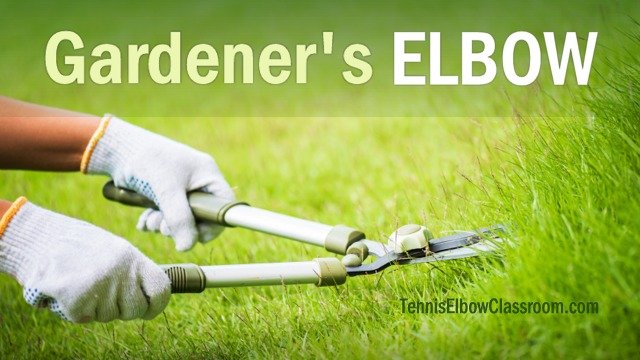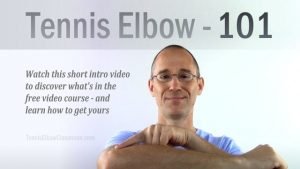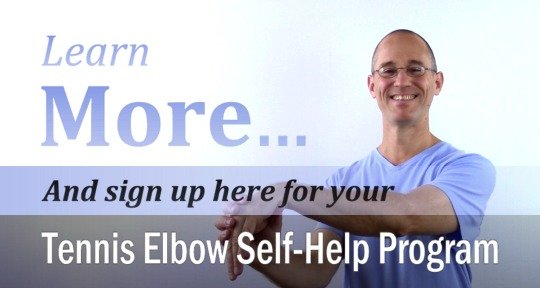
It’s “March Madness” in the Northern Hemisphere now, and a frenzy of activity in the yard or garden for you if you grow veggies or flowers or do your own lawn care and landscaping!
And chances are, you’ll find yourself doing too much gardening and ending up in pain as a result – (But, hey, how can you help getting carried away – It’s springtime!)…
Back and shoulder pain is fairly common, but, unfortunately, gardeners and landscapers very often suffer bouts of wrist and elbow pain that can get severe and even debilitating.
(Of course, even if you’re reading this later in the year, we all know how easy it is to overdo it in the garden or to do too much of anything we love to do outdoors when the weather is right!)
Hence, these kinds of injuries are often known as Repetitive Strain or “Overuse” Injuries.
And Golfer’s Elbow and Tennis Elbow are some of the most common injuries gardeners and landscapers suffer (along with those nasty wrist and thumb tendon injuries / “Tendonitis”)
The Most Common Symptoms Of Gardener’s Elbow
- Stiffness + Soreness – The muscles in your forearm, thumb and hand start to get sore and your elbow and wrist joints feel stiff. And this starts lasting longer and longer, even for a day or two after gardening
- Weakness + Fatigue – You start noticing that you have less and less grip strength for cutting/pruning, holding your garden tools and even carrying things. You feel weak and increasingly fatigued from less and less work.
- Burning or Stabbing Pain – Outright pain in your thumb, wrist or elbow is the surest sign that you’re heading toward injury.
Now, clinically speaking, I should mention that there isn’t really a medical condition known as Gardener’s Elbow…
It’s probably Tennis Elbow / ‘Lateral Epicondylopathy’ – IF the pain is in your outer elbow area (where the tendons of your Wrist and Finger Extensor Muscles originate from a little bony knob, known as the Lateral Epicondyle)
It’s most likely Golfer’s Elbow / ‘Medial Epicondylopathy’ – IF the pain is in your inner elbow area (where the tendons of your Wrist and Finger Flexsor Muscles originate from a little bony knob, known as the Medial Epicondyle)
The pain can be a steady, dull burning or it can rise to the level of a sudden, sharp, stabbing pain, whether at the elbow, wrist or hand.
Before we go further, if you don’t already have a good sense of which one you have, Tennis or Golfer’s Elbow – Or IF you have one of these problems at all…
I invite you to take my free video course called ‘Tennis Elbow 101’ – You’ll learn the differences between Golfer’s and Tennis Elbow, and I’ll walk you through some simple tests you can do to quickly assess yourself.
Here’s where you can learn more and get the free Tennis Elbow 101 Video Course
The 3 Gardening Activities That Cause The Most Harm
3. Carrying and Lifting
Lifting and carrying larger plants, bags of soil, fertilizer or mulch or buckets of water can be especially hard on the back and shoulders.
Of course, holding and handling these often awkward things can be a strain on the muscles of the wrist and fingers, which can lead to wrist tendon issues and to Golfer’s and Tennis Elbow at “the other end” where these muscles originate at the inner and outer elbow.
2. Digging / Pulling / Weeding
The same goes for all the digging and pulling motions, whether simply weeding by hand or digging holes with a shovel or trowel.
We should also include the motions involved in watering with a hose and things like weed whacking and hedge trimming.
Reserving a special place in tendon pain hell for those weed whackers, leaf blowers and mechanical trimmers, with their weight, vibrations, awkwardness added to the requisite gripping and repetitive motions involved in using them.
Pure misery when one is injured!
1. Gripping and Squeezing
But the #1 worst activity overall, (and a part of the other motions) is undoubtedly all the gripping and squeezing that gardeners and landscapers have to do so much of.
It’s the constant gripping and holding or repetitive squeezing motions inherent in using manual clippers, trimmers and shears that really gets you.
How Do The Repetitive Motions Of Gardening Cause Golfer’s Or Tennis Elbow?
There is all too often a gap or oversimplification between “overuse” and “injury”
Yes, simply doing a task repeatedly enough times is going to overload muscles and tendons and cause aches and pains and, eventually, injury.
But, at the same time, we know that the body is capable of adapting to increased physical demands by getting stronger.
There’s something insidious about repetitive motions that can sometimes end up wearing us down, rather than causing us to get better and stronger, however.
This can get complicated, so lets just focus on 3 key aspects of this dynamic:
- Muscle Tension
- Muscle Adhesions
- Tendon Damage
Muscle Tension (And Fatigue)
A lot of gardening activities require less that ideal postures, positions and motions.
For example, all the bending over, the sustained awkward positions, reaching, gripping tools, pulling, etc.
And making a lot of little motions over and over – especially squeezing clippers and pruning tools.
All of which tends to produce excessive muscle tension – (And WHO takes breaks to stretch and rest!)
Conversely, taking a long walk will not tend to produce much muscle tension.
Sure, walking is repetitive, but it involves a lot of muscles moving rhythmically though a fuller range of motion, which tends to cause less problems.
That’s not to say that it’s “unnatural” to hold a pair of pruning shears and repeatedly squeeze them to trim a bed of roses.
And you can adapt to this and get stronger and more conditioned to it like one can to any exercise.
IF you gradually acclimate to this activity!
It’s just that these kinds of small, repetitive motions are notorious for causing a lot of muscle tension and fatigue when overdone, which leads to…
Muscle Adhesions – “Stuck Stuff”
What the heck are ahesions!? I wouldn’t be surprised if ‘Adhesion’ is a term you haven’t encountered before.
It means basically what it sounds like: Stuck stuff!
Layers of muscle and other tissues sticking together.
This is a process that happens slowly in all of our bodies – only more so in areas that are excessively tight and fatigued.
Tension, compression and reduced circulation / oxygen cause the collagen protein in our tissues to gradually stick together.
The more adhesions form, the more restricted the muscle becomes.
This restriction is similar to tension – only you can’t just stretch or relax this “tension” away.
It’s like velcro that’s binding layers of your muscle together.
And like velcro, (which can be separated, but takes effort) ahesions can be released – but only with the right kind of effort, (which we’ll get to.)
However, if adhesions continue to build up and the muscle continues to become “tighter” and more restricted, this can eventually begin to injure the tendons it’s attached to.
Tendon Damage – “Tendonitis” / Tendinosis
In the beginning a tendon (which is the “connector” of muscle to bone) may only hurt for brief periods.
Stress to tendons from repetitive motions does not cause immediate damage – like tears – any more than it causes sudden damage to the muscle.
It’s a gradual, cumulative process.
The pain will likely, initially only be a warning that the tendon is overloaded.
If we take heed and care it may recover without being damaged.
Of course, we don’t tend to do that! We tend to press on!
There may be a period where the tendon gets inflamed – The “Classic Tendonitis” condition you hear so much about.
But that stage will often pass after a few weeks…
If we take heed and care the tendon may heal and recover…
(Inflammation is a stage of the healing process, after all.)
But with continued stress and overload, the tendon healing process is notorious for failing and falling into a state of degeneration.
This state of degeneration is known as Tendinosis to distinguish it from Tendonitis.
In the simplest terms it’s a failure of the healing process to keep up with the strain and the tendon structure (Collagen Protein fibers) degrades and loses it’s strength and integrity. It breaks down.
And it hurts like heck!
Tendinosis is unfortunately what most chronic tendon injury sufferers are facing, whether it’s Tennis or Golfer’s Elbow or another, similar tendon condition.
So, if you’ve had Gardener’s Elbow for several months, (especially 4-6 months or longer) it becomes a lot more likely that your tendon injury has become degenerative.
The Tendonitis / inflammation comes and goes in the early stages (if it happens at all) – Your body tries to heal but fails and it “goes the other way.”
Instead of RE-generation, which = HEALING
You get Degeneration, which = Breakdown / DECAY
The bad news is that Tendinosis is more difficult to heal and recover from than Tendonitis – (But you probably already guessed that.)
Not to say that you can’t recover from it! Our bodies have remarkable abilities to heal – BUT…
This requires encouraging the healing process rather than discouraging, interfering with or outright suppressing it!
How To And How NOT To Treat These Injuries!
The big problem is that the standard treatments and “conventional wisdom” are all about suppressing symptoms rather than encouraging and helping the healing process.
- Anti-inflammatories suppresses inflammation – Which is a necessary stage of healing,
- Icing reduces circulation – Tendons need more blood flow, not less,
- Lotions and creams are not harmful – But not they’re not really helpful, either,
- Cortisone Shots are terrible for tendons – The worst mistake people make,
- Braces and Splints immobilize – Which is not good for these kinds of tendon problems
So, What’s The RIGHT Way To Treat It, Then?
- We mobilize our muscles and tendons with specific hands-on techniques, and gentle stretches (instead of immobilizing them with a brace) See this article and video on the importance of Advanced Self-Massage Techniques
- We warm the area regularly to stimulate circulation and the healing that comes with good blood flow (or at least refrain from freezing our muscles and tendons with ice and inhibiting circulation)
- We allow the inflammation process to do what it’s there to do, which is to initiate the healing process (rather than relentlessly trying to suppress it through pills, shots and ice)
- And we delay rehab exercises – Yes, strengthening exercises are essential at the right time, but the problem, in my experience, is that they’re often begun too early
Our approach here at Tennis Elbow Classroom is to postpone rehab exercise until we first make some progress with the Therapy Techniques and the worst symptoms have significantly subsided…
Here’s more on The Tennis Elbow Classroom Treatment Strategy
And here’s more about The Three Key Principles Of Rehab Exercise
AND if you need some help putting together a self-help plan, you’re certainly in the right place!…
Learn To Treat And Heal Your Own Tennis Elbow Or Golfer’s Elbow At Home With This Video Program
You’ll get instant access to a complete VIDEO program designed by a professional therapist to help you take charge and break your vicious cycle of pain and frustration!…I’ll be your personal tutor guiding you through step-by-step video lessons, where you’ll get the therapy techniques, key stretches and essential exercises you need to treat and recover from your injury at home. (Without any special equipment.)
Just watch the videos, follow along and start putting an end to your elbow pain today, whether you have Golfer’s or Tennis Elbow from gardening, landscaping – (OR, maybe partly from your computer use or guitar playing!)
Tennis Elbow sufferers: Learn more about the self-help program here
Golfer’s Elbow sufferers: Learn more about the Golfer’s home program here








Leave a Reply